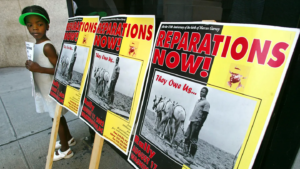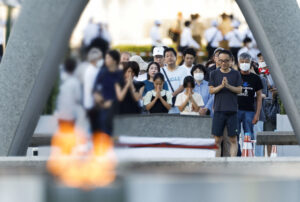PIKINE, Senegal (AP) — Mouhamed Sall stepped to the chalkboard with a glance and quick question in sign language to an assistant. Then he solved the exercise to the silent approval of his classmates, who waved their hands in a display of appreciation.
Sall and three other students are part of a new approach in a small number of schools in Senegal that seat those who are deaf and hard of hearing with the rest of the class.
Some classmates at the sun-washed Apix Guinaw Rails Sud school in a suburb of the capital, Dakar, have embraced the chance to learn sign language in the months since Sall arrived. The class is lively and cheeky: “No teachers allowed in this room,” graffiti scrawled above the chalkboard says.
“I have no problem communicating with some colleagues I went to primary school with,” Sall said as his mother spoke. “The new colleagues don’t know sign language but we still play together.”
“We’ve been friends, so it was easy to learn sign language,” said classmate Salane Senghor, who also knew Sall in primary school. New classmates were curious, looking to the assistant to find out what he was saying.
The United Nations children’s agency says about 60% of children with disabilities in Senegal are not going to school. But the government lacks comprehensive data on the issue and counts only children who are formally registered as having a disability.
“We’re looking for progress from the government to ensure every child, regardless of ability, has the opportunity to learn,” said Sara Poehlman with UNICEF Senegal.
MORE FROM SENEGAL
Senegal lacks a national strategy for inclusive education, but it is developing one. Recent political instability in the West African nation has hindered progress.
The challenges are compounded by a stigma that some in Senegal associate with disabilities. Some parents hide their children and prevent them from participating in society.
But attitudes are changing. In 2021, Senegal’s football team for deaf and hard of hearing players won the first African football championship for such teams and played in the world championship, to the congratulations of Senegal’s president. During the recent election, the National Association for the Promotion of the Deaf in Senegal and the International Foundation for Electoral Systems organized a workshop to teach hard-of-hearing voters over 100 election-related terms in sign language.
Now there’s more visibility in classrooms.
The organization Humanity and Inclusion last year began partnering with Senegal’s education ministry for mixed classes in four public secondary schools with inclusive education practices. Apix is one of them. Humanity and Inclusion funds the hiring of assistants who can communicate in sign language.
“We see that all children are on an equal footing, and that’s why we make an inclusive class or school by harmonizing with the hearing pupils,” said Papa Amadou, one assistant.
Sall is receiving education free of charge, a big advantage in a part of the world where school fees can be a constant source of stress for parents.
Until now, Senegal has had mostly specialized schools for children with disabilities, but they are often private and expensive.
Sall’s mother, Khadija Koundio, at first paid about $17 every month for him to attend an activity center for children with learning challenges in their neighborhood. Then he was able to enter primary school with the support of a similar Humanity and Inclusion program created several years ago in a small number of schools for younger students.
Omar Diop, head supervisor at Apix, praised the new secondary school program but said challenges continue.
“It’s their first year for the teachers, so that poses a problem because the children come with a much higher level of sign language,” Diop said.
Mamadou Konte, the Apix school director, emphasized the need for more teacher training. “We’ve seen success at our school, but this model needs to be replicated nationwide,” Konte added.
Challenges remain for students and families, too. Koundio, president of the parents’ association for the school’s deaf and hard-of-hearing students, said some of her son’s classmates live farther away and struggle with the cost of commuting.
Poehlman with UNICEF highlighted government initiatives like the Carte de l’Égalité, which provides financial assistance to families so children can access specialized schools, but she stressed the importance of programs implemented in public schools.
Jandira Monteiro with Humanity and Inclusion urged collaboration between Senegal’s ministries of health and education to ensure holistic support for children with disabilities.
Sall said he feels accepted by his peers. The teachers at Apix commend him on his intelligence and his artistic talents in crafting bright models of houses and traditional boats called pirogues.
His mother wants him to pursue his passions, including art.
“One day, when I’m gone, he’ll have enough to support himself,” she said.
___
Ndeye Sene Mbengue in Dakar, Senegal, contributed to this report.
___
The Associated Press receives financial support for global health and development coverage in Africa from the Bill & Melinda Gates Foundation Trust. The AP is solely responsible for all content. Find AP’s standards for working with philanthropies, a list of supporters and funded coverage areas at AP.org.




